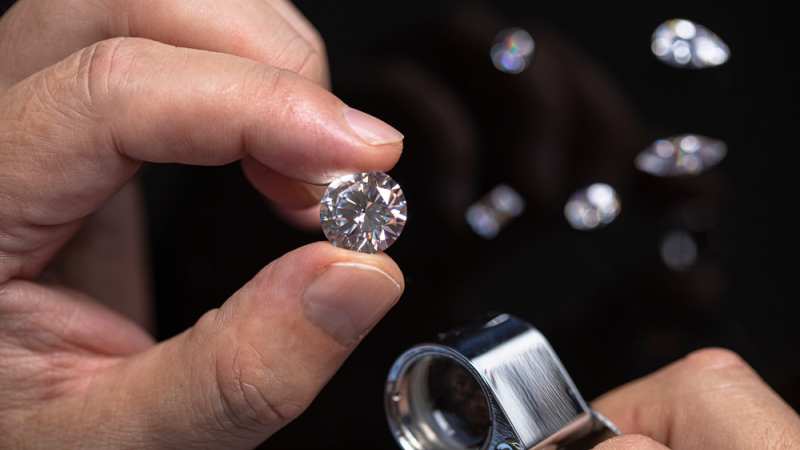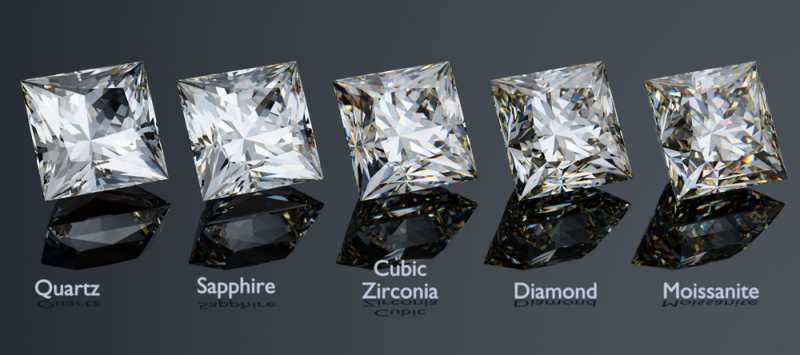As many of you are aware, diamonds are not only the hardest substance known to man but also one of the most expensive and beloved gemstones, captivating us with their sparkle and beauty.
However, the high cost of diamonds has led to the growing popularity of diamond simulants.
Now, you might be wondering: What exactly are simulated diamonds?
A simulated diamond is a material that closely resembles a natural diamond, sharing some of its characteristics. However, simulated diamonds differ in their optical and physical properties, chemical composition, and crystal structure, which is why they come at a significantly lower cost than genuine diamonds.
Simulated diamonds, also known as “diamond simulants” or “substitutes,” can be either naturally occurring or artificially created.
But how can we differentiate between a simulated diamond and a natural or lab-grown diamond? To discover the answer to this question and more, be sure to read the full article!
DESIGN YOUR OWN ENGAGEMENT RING: START WITH A SETTING OR START WITH A DIAMOND. IT’S REALLY UP TO YOU!

What Is The Difference Between Simulated And Synthetic Diamonds?
Despite the misconception that “simulants” and synthetic diamonds are the same, they are indeed different.
Synthetic diamonds, also known as lab-grown, cultivated, man-made, or artificial diamonds, are genuine diamonds created in a laboratory, sharing the same chemical characteristics as natural diamonds. The only distinction is that synthetics are artificially produced.
Unlike simulated diamonds, which are imitations, synthetic diamonds are real diamonds. Identifying a lab-created diamond can be challenging, often requiring specialized diamond testing equipment.
Learn More: Lab-created Diamond Vs. Natural Diamond
Recognizing a Simulated Diamond
That stunning, sparkling gem you desire may not be a genuine diamond at all. You might be surprised to discover how many gems at jewelry stores are simulated diamonds.
So, how can you identify a simulated diamond and differentiate between different types? It helps to be aware of certain characteristics when making a choice.
Hardness Level
Diamonds rank as the hardest material on Earth on the Mohs scale with a score of 10/10. Most simulated diamonds cannot match that level of hardness.
Simulated diamonds are less durable than natural ones and cannot withstand daily wear. They are susceptible to scratches from fingernails, coins in pockets, and even household dust. Surprisingly, dust contains tiny particles of quartz, which ranks “7” on the Mohs scale and poses a significant threat to jewelry and simulated gems.
Brilliance Level
Diamonds’ exceptional hardness and single reflectiveness make them easier to polish compared to other gems and imitations. This quality gives diamonds a superior sparkle.
While few simulated diamonds may exhibit more fire and brilliance than diamonds, some imitations display a double reflection, producing a visible rainbow sparkle. The presence of a rainbow sparkle is an indication of a diamond imitation.
Density Level
It’s worth noting that diamond imitations have varying densities. Consequently, a simulated diamond with lower density than a genuine diamond may appear larger, while an imitation with higher density could appear smaller despite having the same carat weight.
Clarity Level
Natural diamonds often contain inclusions that formed within their structure during the stone’s development. In contrast, simulated diamonds and lab-grown diamonds typically lack such internal flaws, appearing flawless but not in a desirable way.
Related Read: Diamond Clarity Chart: Everything You Need To Know
Color Quality
Diamond color plays a crucial role in identifying a genuine diamond. While colorless diamonds are somewhat rare, they do exist. Simulated diamonds, on the other hand, are usually manufactured to be colorless.
Therefore, when comparing a genuine diamond with a simulant, the simulant may appear “whiter.”
Type of Setting
Although a simulated diamond doesn’t necessarily require a cheap metal setting, its main selling point is affordability. Consequently, it’s unlikely for jewelry sellers to use precious metals for the setting of a simulated diamond, as it would increase the overall cost.
Therefore, a simulated diamond is commonly set in a silver setting type.

Popular Simulated Diamonds
Various types of simulated diamonds are available, each with its own composition, quality, and appearance. Here is detailed information about some popular gemstones:
Cubic Zirconia (CZ):
Also known as CZ, cubic zirconia is a synthetic gem made of zirconium dioxide. It is considered the second-best substitute for diamond due to its diamond-imitating qualities. While it can occur naturally as mineral baddeleyite, it is primarily created in labs. Cubic zirconia ranks 8.5 on the Mohs scale, making it softer than other diamond simulants. It emits a rainbow of colors in natural light and produces a disco ball-like effect in sunlight. Despite being affordable, cubic zirconia lacks the resale value of diamonds.
Synthetic Moissanite:
Discovered by French scientist Henri Moissan in 1893, moissanite is a rare gem made of silicon carbide. It is considered the best simulated diamond to date. It is exceptionally hard with a ranking of 9.25 on the Mohs scale, making it suitable for everyday activities. Synthetic moissanite exhibits twice the dispersion and similar specific gravity as a diamond. It often has greater fire than a real diamond but can create a disco-ball effect, distinguishing it as a simulant.
White Topaz:
White topaz is a silicate mineral composed of aluminum and fluorine. While it comes in various colors, its original form is transparent. With a hardness of 8 on the Mohs scale, it is softer than cubic zirconia and unsuitable for daily wear. White topaz has a glossy appearance and prismatic crystals, resulting in lower shine. Even with slight flaws, it can still appear clean to the naked eye. The round white topaz cut is commonly used as a diamond imitation.
White Sapphire:
White sapphire belongs to the corundum group of gems. It is very hard, ranking 9 on the Mohs scale, and durable, making it suitable for everyday wear. However, it lacks optical similarities to a diamond and can appear cloudy. White sapphire can be natural or lab-grown, with similar characteristics between the two types. Choosing a smaller size for white sapphire helps minimize the visual differences from a diamond.
Quartz:
Quartz, also known as Herkimer diamonds or rock crystal, is a common mineral composed of silicon dioxide. It ranks 7 on the Mohs scale, making it unsuitable for daily wear due to its softness. Quartz comes in various colors, including colorless forms. Its reflection index is significantly lower than that of a diamond, resulting in a different sparkle, appearing twinkly rather than sparkly.
Synthetic Rutile:
Synthetic rutile, introduced in 1948, has a higher reflective index dispersion than a diamond, making it slightly more brilliant. It exhibits fire more than seven times greater than that of a diamond. However, it has a low hardness rating of 6.5 on the Mohs scale, making it prone to abrasion injuries. Synthetic rutile is also double reflective, causing a blurry image of the stone’s inner side.
Gadolinium Gallium Garnet (GGG):
Gadolinium gallium garnet is a synthetic gem used as an early diamond substitute. It is manufactured through the Czochralski method and can be produced in various colors. GGG is denser than a diamond, but it is considerably softer with a ranking of 6.5 on the Mohs scale, making it less suitable for daily wear.
Yttrium Aluminum Garnet (YAG):
Yttrium aluminum garnet, also known as “diamonair,” first appeared in 1969. It is a synthetic gem created through the Czoch
ralski method and has a structure similar to natural garnets. It has a hardness of 8 on the Mohs scale and high clarity but a lower refractive index and greater weight than a diamond of the same size. Yttrium aluminum garnet is not a popular simulated diamond and is mostly found in vintage jewelry.

Conclusion
It is widely known that diamonds hold immense value and are highly sought after in the world of jewelry. However, scientists continue to develop various types of simulated diamonds.
So, what exactly are simulated diamonds?
Simulated diamonds are often beautiful alternatives to diamonds, either natural or artificially created. However, they differ in composition and optical properties from genuine diamonds, which means their long-term value is not as significant. Nevertheless, they are more affordable.
That being said, some simulated diamonds, such as synthetic moissanite, possess optical dispersion and hardness that closely resemble those of diamonds, making them difficult to distinguish. In other words, a simulated diamond does not necessarily come across as “fake.”


